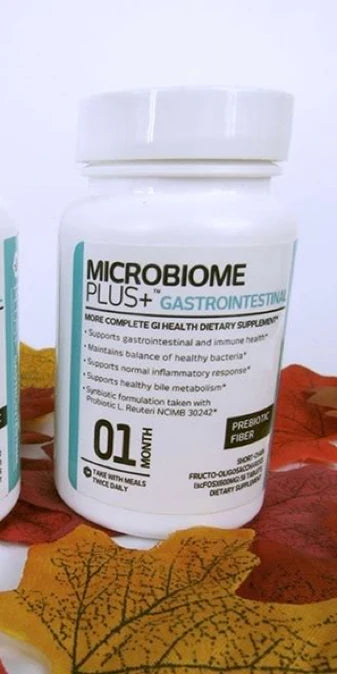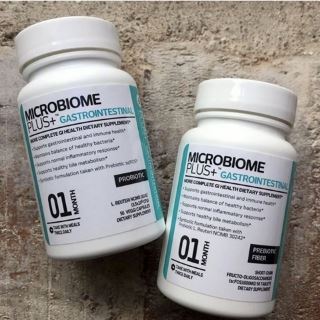The “sunshine vitamin” helps keep your bones and immune system strong. Many people are at risk of deficiency and wonder if they can get enough from the sun and diet alone. What does the evidence say about how much you need, whether you should get tested, and what vitamin D doses work? The latest 2024 guidelines look at recent research in a new light and surprise many.
Disclaimer: This post is for informational purposes only. Please discuss your health concerns with your care provider and consult them before taking any supplements to avoid disease and drug interactions.
Buy Microbiome Plus+ Vitamin D Supplements
What Is Vitamin D?
Vitamin D is a hormone and nutrient your body needs for good health. Your body produces vitamin D as a response to sun exposure.
Your body needs vitamin D to absorb calcium and phosphorus, minerals that build and maintain strong bones. Vitamin D also supports nerve and brain health, immune health, heart health, and muscle function (Rebelos et al., 2023).

Vitamin D Food Sources
You can get small amounts of vitamin D from your diet. Foods naturally contain very small amounts of vitamin D.
Some sources of vitamin D include (Benedik, 2022; Schmid & Walther, 2013; Cardwell et al., 2018):
- Fatty fish: wild-caught salmon, sardines, tuna
- Mushrooms: fresh shiitake, mushrooms treated with UV light
- Fish liver oil: cod liver oil
- Egg yolk
- Beef liver
- Dark chocolate
- Fortified foods: breakfast cereals, juice, yogurt, and plant-based milk alternatives.
Americans get more vitamin D from fortified foods than from foods that naturally contain it (Benedik, 2022).
Vitamin D Deficiency
Causes
Swiss researchers found that adults can produce the recommended daily dose of vitamin D (1000 IU) in 10-15 min of sun exposure in the summer and spring. Participants achieved this with 22% of uncovered skin, such as by wearing short sleeves and shorts (Religi et al., 2019).
In winter and autumn, though, the same proved to be impossible. With only around 10% of skin exposed to the sun’s UVB rays, it would take over 6 hours of exposure each day to get enough vitamin D. Sunbathing for so long is difficult and increases the risk of sunburns (Religi et al., 2019).
Limited sun exposure, clouds, smog, regularly using sunscreen with an SPF greater than 8, old age, and having dark-colored skin all reduce the amount of vitamin D your skin makes. Gut disorders, liver disease, kidney disease, strict vegan diets, obesity, and certain medications may also increase your risk of deficiency (NIH).
Diet plays in, but to a small extent. In the Swiss study, food made up only 10% of the recommended vitamin D intake and remained unchanged throughout the year (NIH).
For these reasons, many people struggle to get enough vitamin D year-round. Vitamin D deficiency is so common that it’s been called a “pandemic” by some researchers. Over one billion children and adults worldwide have vitamin D deficiency (Holick, 2017).
For people with deficiency or known risk factors, vitamin D dietary supplements are usually recommended.
Summary
Your body uses sunlight to make vitamin D. It's easier to get enough in the summer, but in winter, it's harder because there's less sun and we wear more clothes. People with darker skin or certain health conditions may have trouble getting enough vitamin D and require supplements.
Symptoms
Symptoms of long-term vitamin D deficiency may include (Bordelon et al., 2009; Sizar et al., 2023):
- Bone or muscle pain
- Constant low back pain
- Tiredness, aches, and weakness
- Muscle twitching
- Bone fractures
- Bone density loss and osteoporosis
- Rickets in children
Recent studies suggest an association between vitamin D deficiency and cancer, cardiovascular disease, diabetes, autoimmune diseases, and depression. More research is needed to understand how low vitamin D may affect these and other disease (Sizar et al., 2023).
Summary
If you don't get enough vitamin D for a long time, you might feel pain in your bones or muscles, get tired easily, and your bones could become weaker and break more easily.
How to Know if You’re Deficient
One way to find out if you’re getting enough vitamin D is to do a blood test that measures the amount of this vitamin in your blood. This blood test measures the amount of 25-hydroxy vitamin D (25(OH)D) in your blood (NIH).
Vitamin D deficiency is relatively common in the United States. It’s defined as 25(OH)D blood levels of 20 ng/mL or below (Pludowski et al., 2023).
As of recently, the Endocrine Society suggests against routine vitamin D laboratory testing because it’s unclear what the ideal levels for disease prevention should be (Shah et al., 2024).
Since testing is controversial, it’s best to discuss with your health care provider if it may be beneficial to check your vitamin D level.
Is there such a thing as “suboptimal vitamin D” and “vitamin D insufficiency”?
The National Institute of Health (NIH) estimated that 97.5% of the population do not need their 25(OH)D levels to be higher than 20 ng/mL to satisfy their bone health needs. There was no evidence of added benefits at levels over 20-24 ng/mL (McCartney et al., 2024).
In light of this, in 2024, the Endocrine Society revised its guidelines. Based on new research, they stress that there’s no evidence to classify people as “insufficient” or “borderline low” if their levels are 20 ng/mL - 30 ng/mL.
If your levels are within this range and you’re generally healthy, you probably have nothing to worry about.
They also emphasize that there is no such thing as “optimal vitamin D levels” or “vitamin D sufficiency” based on levels over 30 ng/mL—a category they previously endorsed (McCartney et al., 2024).
Summary
New 2024 guidelines say that evidence doesn’t support routine vitamin D testing. This is because the ideal vitamin D levels for disease prevention are unclear and more research is needed.
How Much Vitamin D Should I Take?
Vitamin D Recommended Daily Allowances
The guidelines on how much vitamin D a person needs have changed over the years.
Your daily vitamin D needs depend on individual factors such as your age, sex, health status, and lifestyle.
Despite a lot of research on vitamin D, the optimal vitamin D intake and blood levels for disease prevention still need to be determined.
For example, the National Academy of Medicine (NIH) places the recommended dietary allowance, or RDA, for vitamin D at (Rosen et al., 2012):
- Infants (0–12 months): 10 micrograms (mcg) or 400 international units (IU)
- Children and teens: 15 mcg (600 IU)
- Adults ages 18–70: 15 mcg (600 IU)
- Adults over age 70: 20 mcg (800 IU)
- Pregnant and breastfeeding women: 15 mcg (600 IU)
The new 2024 Endocrine Society guideline on vitamin D suggests additional supplementation above the RDA only for children and adolescents 18 and younger, people over 75 years, who are pregnant, or who have high-risk pre-diabetes. They also recommend against routine testing for vitamin D levels in these groups.
New guidelines don’t mention a specific dose in any of these cases since research is lacking to make a firm dosage recommendation.
Suggested Vitamin D Dosage Based on Research
A team of Polish researchers argues for a higher daily vitamin D3 supplementation dosage of 2000 international units (IU) (50 µg) to prevent and correct vitamin D deficiency (Pludowski et al., 2024).
Based on published randomized controlled trials, they claim that this dose may improve some health outcomes and is high enough to raise and maintain vitamin D levels above the deficiency threshold in >99% of adults.
They found no significant safety concerns in people who took this dosage for several years, even if they were not deficient to start with.
Researchers concluded that vitamin D supplementation with 2000 IU/day may be simple, effective, and safe for most people (Pludowski et al., 2024).
However, more research is needed before official dosage recommendations are made.
Our Vitamin D supplement contains 2000 IU in each softgel to help most people meet their vitamin D needs.
Summary
The official RDA for vitamin D is 600 IU for all children and adults and 800 IU for people over 70 years old. Higher doses may be needed in specific populations. Some researchers argue for a higher daily dosage (2000 IU/day) for all, but more research is needed.
Is it Better to Take Vitamin D Every Day or Once a Week?
It’s safer and more effective to take vitamin D at the recommended dose every day.
According to 2024 Endocrine Society guidelines, lower-dose vitamin D is better than weekly higher-dose vitamin D in adults ages 50 years and older who need supplementation.
New research warns that high-dose intermittent vitamin D may increase falls, compared to lower-dose daily dosing (Shah et al., 2024).
Vitamin D Side Effects
Vitamin D is considered safe when taken in recommended amounts.
Taking too much vitamin D can lead to serious side effects, particularly at doses higher than 4000 IU per day for long periods of time (NIH).
Very high levels of vitamin D in your blood (over 375 nmol/L or 150 ng/mL) can cause hypercalcemia, excess calcium in the blood. Hypercalcemia can lead to vomiting, nausea, muscle weakness and pain, dehydration, urinating too much, and even kidney stones (NIH).
At even higher levels of vitamin D, there’s a risk of kidney failure, pancreas inflammation, irregular heartbeat, and even death (NIH).
Dangerously high levels of vitamin D are almost always caused by taking too many vitamin D supplements. You cannot overdose on vitamin D from the sun because your skin limits the amount of vitamin D it makes.
If you suspect vitamin D deficiency, be sure to consult a healthcare professional before beginning a high-dose regimen.
Read Next:
- Are Your Gut Microbiome Bacteria Healthy or in Dysbiosis?
- Ubiquinol vs Ubiquinone: Which CoQ10 Is Better?
- Is Coconut Oil Bad for Cholesterol & Heart Health? (2023)

Ana Aleksic, MSc (Pharmacy)
Ana is an integrative pharmacist and scientist with many years of medical writing, clinical research, and health advising experience. She loves communicating science and empowering people to achieve their optimal health. Ana has edited 1000+ and written 400+ posts, some of which reached over 1 million people. Her specialties are natural remedies, drug-supplement interactions, women’s health, and mental health. She is also a birth doula and a strong advocate of bridging scientific knowledge with holistic medicine.







